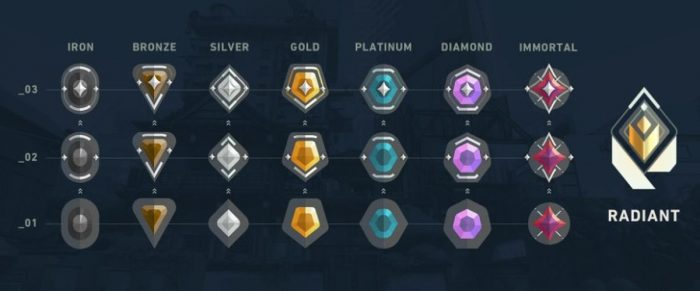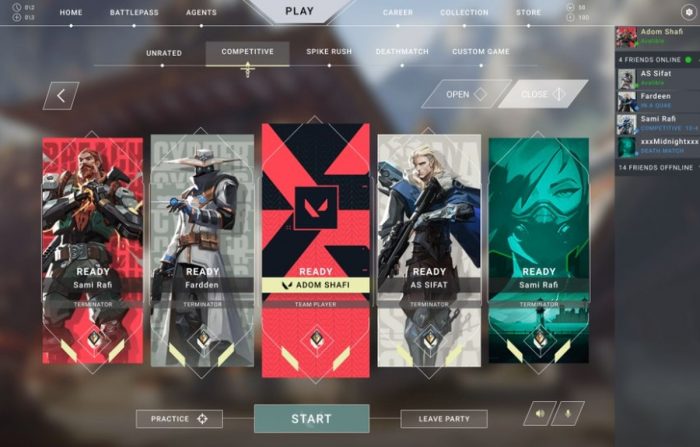Although it’s just over a year old, Valorant has cemented itself as one of the most popular free-to-play games thanks to its highly competitive gameplay.
Much like any other competitive multiplayer game, Valorant has a ranking system which can be a bit confusing. If you’re a new or a returning player, you probably want to party up with someone and take on the ranked challenge together.
To make it easier, we’ve prepared a comprehensive table of every rank that can play together.
Parties of two or three players
| Lowest rank in the group | Highest rank in the group |
|---|---|
| Unranked | Gold |
| Iron | Silver |
| Silver | Gold |
| Gold | Platinum |
| Platinum | One tier higher max ( for example a Diamond 1 player can queue with up to Ascendant 1) |
Ranked restrictions for small parties
The current Valorant ranking structure consists of nine tiers of ranks, ranging from Iron to Radiant.
Except for Radiant which is a separate elite tier for the best players, every Valorant rank tier has three sub-ranks, with rank one being the lowest and rank three being the highest.
To create a fair matchmaking system that matches players of similar rank and skill level, there are certain restrictions when it comes to queueing up in parties of two and three.
Unranked restrictions
Players that have recently started playing ranked and who are still without a shiny badge that represents their skill can play with ranks up to Gold.
However, if two unranked players attempt to play in a party of two, their hidden MMR will determine whether they can play or not.
In certain situations, if your hidden MMR is too low or too high, you won’t be able to able to play even if you still haven’t received your definitive ranking.
Low elo restrictions (Iron – Silver)
The lowest ranks on the ladder which are Iron and Bronze can play with anyone up to Silver, which means that an Iron 1 player can play with a Silver 3, as long as the Silver player is the highest ranked player in the lobby.
High elo restrictions (Gold+)
The restrictions get a bit steeper in higher elo, where players that are Gold or higher can only play with players that are within one rank of them.
Furthermore, players ranked Immortal or higher cannot play in a party of three and can only play solo, duo, or with a 5-stack premade party.

How can I play with my high/low elo friend?
Purchase a Valorant smurf account
One of the best solutions that dodges all of the restrictions we’ve previously mentioned is to buy a Valorant ranked ready account.
If you’re playing with a friend who is ranked much higher or lower than you, it’s a perfect idea to purchase a ranked-ready account with fresh MMR and start the ranked journey together.
Generally, having a smurf is an amazing idea as you can always unwind from your ranked games by playing on your smurf account and stomp low elo players.
Purchasing a smurf account is also a stellar idea if the MMR on your main account is really bad and you need a fresh start on an account with untouched MMR.
Create a smurf account
Another great alternative is to create your smurf account instead of purchasing it. However, the biggest downside of choosing this method is the fact that you’re going to have to manually level the account yourself.
This process is very tedious and time-consuming and it takes more than 20 hours for an average player to reach level 20 and begin their ranked journey.
Play a five-stack premade group or unrated
While it’s not necessarily the best solution as it often results in RR losses, if you want to play with your friend who is ranked much higher or lower than you, you can play in a five-stack group, as long as you can find enough players to fill a lobby.
Alternatively, you can just settle for playing unrated, but most players tend to stay away from that game mode as it doesn’t impact your rank and it’s not very competitive.
Get boosting
If you aren’t familiar with the term, boosting is a process in which you pay a high elo player to boost the rank of your account by playing on the account and winning games.
This procedure breaks Riot’s terms of service and it’s a bannable offense that can be very risky if you’re not getting boosted by professionals that put the safety of your account as their priority.
Regardless, many players gravitate towards boosting as they desire to increase their rank with no effort, and boosting is often the only way to reach the necessary rank to play with their friends.
Parties of four players
Unfortunately, a group of four friends cannot queue up to play as four-player parties are currently not allowed.
The developers took these steps to improve the quality of matchmaking and steer clear of pairing solo players with four-person premade groups, which frequently results in a subpar solo gameplay experience and unnecessary toxicity.
Five-stack premade groups

Which ranks can play together?
You’re in a very fortunate position if you’re queuing up with a premade group of five people, as there are no restrictions on this queue type.
No matter your rank, you can queue up with anyone in a five-stack party, regardless of the rank disparity between you.
To put things into perspective, an Iron player can theoretically play with a full team of Ascendants as long as the group is full and consists of five premade players.
Five-stack premade penalties
Theoretically, it would be a nightmare to fairly distribute RR among players in a five-stack party who have a large rank disparity between themselves.
That is why Riot introduced party penalties that lower RR gains for five-stack groups with large rank gaps among the members.
Low elo penalties
Your group has to consist of players that are within two ranks of each other, or it will suffer a 25% RR penalty at the end of the game.
If the rank disparity increases, the RR penalty increases as well, each time by 25% for every additional rank differential between the highest and the lowest ranked member of the party.
Since this is a complicated subject to handle, we’ve created a table to help you better understand this concept.
| Lowest ranked member of the party | Highest ranked member of the party | Penalty |
| Bronze | Silver | No penalty |
| Bronze | Gold | 50% |
| Bronze | Platinum | 75% |
This specific penalty applies to players that are ranked between Iron 1 and Diamond 2, which is the majority of the player base.
In general, you should be expecting to gain and lose less RR while playing in a five-stack party than you would if you were playing ranked otherwise.
That’s because the system has a harder time fairly distributing RR at the end of each game because of the rank disparity that is often really high.
High elo penalties
Sadly, if you’re a high elo player or you’re playing with one, you’re going to suffer a steep penalty every time you enter a ranked match.
Players that queue up who are ranked between Diamond 3 and Immortal 3 will receive a minimum 50% RR penalty when playing five-stack matches, and everyone in their party will be hit with that penalty as well.
This penalty can increase up to 90% based on the difference between the ranks of the players involved.
Radiant penalty
In order to combat boosting and unfair climbing methods, Radiant players or players in a five-man premade party with a Radiant player will suffer a massive 75% RR penalty every time they queue up.
Furthermore, if there is anyone in the party who is not ranked Radiant among the players in the lobby, the entire party will lose 90% RR at the end of the game.
Five-stack queue times
Generally speaking, if you’re playing in a five-stack party, you’ll have to wait longer because the game naturally finds it more difficult to find a group of five players with a similar average MMR.
If there is a significant rank gap between the players in the group, the queue time will extend even further.
Additionally, high elo players typically have lengthier queue times, most notably Radiant players who frequently have to wait for hours to join a match.
- Unknown Knights Tier List – Best Heroes in the Game [2025 Update] - February 21, 2025
- Best Games Like MapleStory to Play Now - February 21, 2025
- Clover Retribution Codes: Free Goodies to Redeem [NEW UPDATE!] - February 12, 2025

